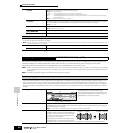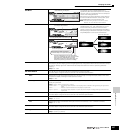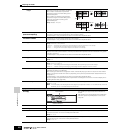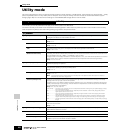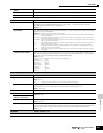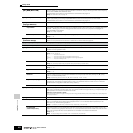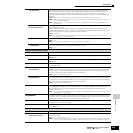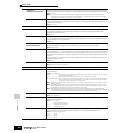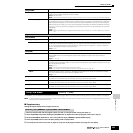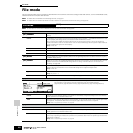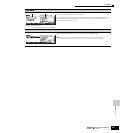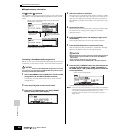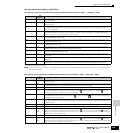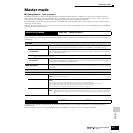
Reference Utility Mode
Utility mode
264
Owner’s Manual
KBDTransCh
(Keyboard Transmit Channel)
Determines the MIDI channel over which the instrument sends MIDI data (to an external sequencer, tone generator,
or other device). This parameter is available in the single-timbre tone generator mode (Voice/Performance modes).
Settings: 1~16, off
n In the multi-timbral tone generator mode (Song/Pattern modes), MIDI data generated by playing the keyboard (and its
controllers) is sent to the internal tone generator and external devices via the MIDI output channel, set from the CHANNEL
display ([SONG] or [PATTERN] → [F3] TRACK → [SF1] CHANNEL).
DeviceNo. (Device Number) Determines the device number used by this synthesizer in receiving or transmitting data. This number must match
the Device Number of the external MIDI device when transmitting/receiving bulk data, parameter changes or other
system exclusive messages.
Settings: 1~16, all, off
[SF2] SWITCH
BankSel This switch enables or disables Bank Select messages, both in transmission and reception. When this is set to “on,”
this synthesizer responds to incoming Bank Select messages, and it also transmits appropriate Bank Select
messages (when using the panel).
Settings: off, on
PgmChange (Program Change) This switch enables or disables Program Change messages, both in transmission and reception. When this is set to
“on,” this synthesizer responds to incoming Program Change messages, and it also transmits appropriate Program
Change messages (when using the panel).
Settings: off, on
CtrlChange
(Control Change mode)
Determines how this synthesizer receives and recognizes the AEG Sustain MIDI message. When set to mode1, it is
received as a Parameter Change. When set to mode2, it is received as a Control Change message.
Settings: mode1, mode2
LocalCtrl (Local Control On/Off) This determines whether or not the tone generator of the instrument responds to your keyboard playing. Normally,
this should be set to “on” — since you’ll want to hear the sound of the MOTIF ES as you play it. However, for external
sequencer applications, you may need to set this to “off” to avoid getting “double” notes, in which the tone generator
of the instrument is played twice — once by the keyboard and once again by the keyboard data routed through the
sequencer.
Even if this is set to “off,” the data will be transmitted via MIDI. Also, the internal tone generator block will respond to
messages received via MIDI.
Settings: off, on
RcvBulk (Receive Bulk) Determines whether or not Bulk Dump data can be received.
Settings: protect (not received), on (received)
[SF3] SYNC (Synchronization)
From this display you can set various parameters related to MIDI clock and synchronization.
MIDI Sync Determines whether Song/Pattern/Arpeggio playback will be synchronized to the instrument’s internal clock or an
external MIDI clock.
Settings: internal, MIDI, MTC
internal ..............................Synchronization to internal clock. Use this setting when this synthesizer is to be used alone or as the master
clock source for other equipment.
MIDI ..................................Synchronization to a MIDI clock received from an external MIDI instrument via MIDI.
MTC (MIDI Time Code).....Synchronization to an MTC signal received via MIDI. MMC signals are transmitted via MIDI. Use this setting
when this synthesizer is to be used as a MIDI slave, such as when synchronized to an MTC-capable MTR.
The MTC Sync function is available only in the Song mode.
n Please keep in mind that the song or pattern will not start even if you press the [F] (Play) button when the MIDI Sync is set to
other than “internal.”
n MTC (MIDI Time Code) allows simultaneous synchronization of multiple audio devices via standard MIDI cables. It includes
data corresponding to hours, minutes, seconds, and frames. This synthesizer does not transmit MTC. A device such as the
Yamaha AW4416 is necessary in order to use this synthesizer as an MTC master.
n MMC (MIDI Machine Control) allows remote control of multitrack recorders, MIDI sequencers, etc. A MMC-compatible
multitrack recorder, for example, will automatically respond to start, stop, fast forward, and fast reverse operations performed
on the controlling sequencer, thus keeping playback of the sequencer and multitrack recorder aligned.
ClockOut Determines whether MIDI clock (F8) messages will be transmitted via MIDI.
Settings: on (transmitted), off
SeqCtrl (Sequencer Control) Determines whether Sequencer Control signals – start, continue, stop, and song position pointer – will be received
and/or transmitted via MIDI.
Settings: off, in, out, in/out
off.....................Not transmitted/recognized.
in ......................Recognized but not transmitted.
out....................Transmitted but not recognized.
in/out ...............Transmitted/recognized.
MTC StartOffset Determines the specific time code point from which sequence playback starts, when MTC is received. This feature
can be used to accurately align playback of this synthesizer with an external MTC-compatible device.
Settings: Hour : Minute : Second : Frame
Hour ................00~23
Minute .............00~59
Second ............00~59
Frame ..............00~29



